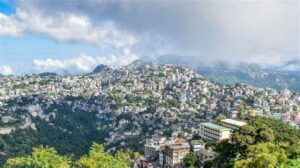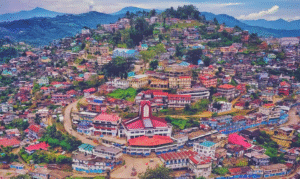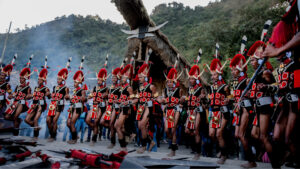Introduction
Maghe Sankranti, also known as Makar Sankranti in other parts of India, is a major cultural and spiritual festival observed by the Nepali community of Sikkim. Falling in the month of Magh (mid-January), this festival marks the beginning of the sun’s northward journey (Uttarayan), which is considered auspicious in Hindu cosmology. In the unique multi-ethnic and spiritual landscape of Sikkim, Maghe Sankranti is a significant celebration, infused with rituals, community bonding, and deep-rooted traditions of the Nepali-speaking populace.
This blog explores the historical, cultural, and spiritual significance of Maghe Sankranti in Sikkim, providing an academic overview of its rituals, societal functions, traditional food, and its evolving relevance in contemporary times.
Historical and Cultural Context of Maghe Sankranti
The word Sankranti refers to the transmigration of the sun from one zodiac sign to another. Maghe Sankranti marks the sun’s transition into Makara Rashi (Capricorn), symbolizing longer and warmer days after the winter solstice. For the Nepali community, this day marks a spiritual milestone — a shift from darkness to light, cold to warmth, and in a symbolic sense, ignorance to knowledge.
The festival has ancient origins rooted in Vedic traditions, particularly the solar calendar. In Nepal and Sikkim, the Maghe Sankranti celebration has persisted for centuries, adapting to local customs while retaining its religious symbolism. Unlike lunar festivals that vary in date, Maghe Sankranti follows the solar cycle and usually falls on January 14 or 15 each year.
Ethnic Relevance in Sikkim
Sikkim is home to diverse communities, including the Bhutia, Lepcha, and a significant Nepali population. The Nepali community in Sikkim comprises various castes and subgroups such as Bahun, Chhetri, Gurung, Magar, Tamang, Rai, and Limbu. While each group has its distinct festivals and rituals, Maghe Sankranti acts as a common celebratory point for many within the broader Nepali ethnicity.
In Sikkim, Maghe Sankranti is not only a religious festival but also a cultural reaffirmation of ethnic identity. It is celebrated with fervor in districts like Namchi, Geyzing, and Gangtok, where large Nepali communities reside. Schools, cultural centers, and community halls organize programs showcasing traditional dances, songs, and communal feasts, all centered around this seasonal celebration.
Ritual Practices and Ceremonial Observances
Holy Baths and Purification
The most prominent ritual associated with Maghe Sankranti is the holy bath or Snan. Devotees take ritualistic baths in rivers and natural springs early in the morning to purify themselves. In Sikkim, rivers like the Teesta and Rangeet become pilgrimage sites during this period.
People believe that bathing in these sacred waters during Maghe Sankranti cleanses one’s sins and offers spiritual rejuvenation. In some places, oil massage and ceremonial cleansing also form part of the traditional morning rituals.
Worship and Offerings
Following the bath, families perform pujas at home or in community temples. Offerings of seasonal produce such as sesame seeds, yams, and molasses are made to deities, particularly Surya (Sun God) and Vishnu. Traditional lamps (diyo) are lit, and prayers are offered for prosperity, health, and harmony.
Some households also worship ancestors during this time, seeking blessings and expressing gratitude. In this way, Maghe Sankranti serves both as a solar worship and an occasion to maintain ancestral connections.
Food and Feasting
One of the most cherished aspects of the festival is the special cuisine prepared on this day. Key food items include:
- Til ko laddu (sesame seed balls): Symbolizing warmth and protection during winter.
- Chaku (molasses or hardened jaggery): A rich source of energy and a traditional winter sweet.
- Tarul (yam): Root vegetables like yam and sweet potatoes are boiled and served with mustard oil and salt.
- Ghee and beaten rice (chiura): These staples form a simple yet nourishing festive meal.
These traditional foods are not just culinary customs but also rooted in seasonal health logic, providing warmth and strength during the cold month of Magh.
Community Gatherings and Social Importance
Maghe Sankranti is as much a social festival as it is a religious one. Community events are organized at public venues, where cultural programs, folk music, dance performances, and sporting competitions like wrestling or traditional games are held. These events serve to strengthen bonds among neighbors, relatives, and local communities.
The festival also emphasizes intergenerational interaction. Elders in the family share stories, distribute sweets to younger members, and bless them. In return, younger people perform gestures of respect and gratitude.
In villages and towns with dense Nepali populations, Maghe Sankranti acts as a cultural glue, reinforcing shared values, oral traditions, and ethnic unity.
Symbolic and Spiritual Significance
Maghe Sankranti is deeply symbolic. It reflects themes of regeneration, transition, and cosmic order. The festival occurs when the sun begins its northward journey — believed to bring light, spiritual progress, and renewed hope. According to Hindu mythology, this period is associated with the return of Bhishma Pitamah (from the Mahabharata) to his heavenly abode after voluntarily waiting for this auspicious time to depart.
For the Nepali community in Sikkim, this cosmic significance translates into a period of reflection, resolution, and religious observance. The consumption of sesame and jaggery symbolizes the absorption of purity and the release of negative energies.
Moreover, the practice of giving and sharing food during Maghe Sankranti is seen as a path to Dharma — a reminder of the values of charity, righteousness, and balance in life.
Regional Variations and Similarities
While the essence of Maghe Sankranti remains consistent, regional variations within Sikkim and neighboring areas add layers of diversity:
- In eastern Sikkim, small fairs are organized where artisans, performers, and locals participate in traditional games and cultural shows.
- In rural pockets, there is a practice of making symbolic representations of the sun with cow dung and decorating them with turmeric and flowers.
- Among the Magar and Gurung subgroups, there are special songs known as Maghe Geet, sung during this period to celebrate nature, harvest, and life.
Interestingly, Maghe Sankranti coincides with other harvest-related festivals like Lohri in Punjab and Pongal in Tamil Nadu, highlighting the pan-Indian importance of the agricultural calendar and the solar transition.
Role of Women and Family Structure
Women play a central role in Maghe Sankranti celebrations. They prepare the festive meals, lead the morning rituals, and organize household events. In many families, elder women hand over symbolic gifts like til ko laddu and ghee to daughters and daughters-in-law, affirming familial bonds and blessings.
The festival also reinforces the importance of unity within the joint family system — where multiple generations come together under one roof for prayers and meals. Respect for elders, care for children, and harmony in family life are key ideals emphasized during Maghe Sankranti.
Evolving Celebrations in Urban Sikkim
With urbanization and modernization, the way Maghe Sankranti is celebrated is gradually changing, especially in towns like Gangtok and Namchi. While the spiritual core remains intact, people are now integrating modern forms of celebration such as:
- Community events organized by Nepali cultural societies
- Use of social media to share greetings and traditional knowledge
- Televised and live-streamed cultural programs
- Inclusion of other ethnic communities in the celebration as a symbol of unity
Even schools and colleges with significant Nepali student populations conduct cultural assemblies and poster exhibitions explaining the significance of the day. This growing awareness and institutional participation are helping preserve and promote Maghe Sankranti beyond just family boundaries.
Challenges and Cultural Preservation
Despite its vibrant presence, Maghe Sankranti faces challenges related to cultural dilution. Younger generations, particularly in urban areas, sometimes see the festival merely as a holiday rather than a cultural experience. Traditional knowledge, especially regarding rituals, songs, and native dishes, is at risk of being forgotten.
Efforts by community elders, local NGOs, and cultural groups are underway to document oral histories, archive folk songs, and conduct workshops on traditional cooking and rituals. There is a growing realization that festivals like Maghe Sankranti are not only about celebration but also about identity preservation and cultural continuity.
Conclusion
Maghe Sankranti is far more than just a religious event for the Nepali community in Sikkim. It is a living tradition that celebrates light, hope, health, and heritage. As one of the most cherished festivals, it binds families, revives customs, and connects the past to the present.
In the lush and multicultural tapestry of Sikkim, Maghe Sankranti shines as a beacon of Nepali ethnic pride, intergenerational unity, and seasonal gratitude. Its celebration reinforces the idea that festivals are not just moments of joy — they are containers of memory, expressions of belief, and markers of identity in a rapidly changing world.






